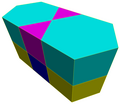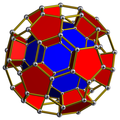Properties
A hexagonal prism has twelve vertices, eighteen edges, and eight faces. Every prism has two faces known as its bases, and the bases of a hexagonal prism are hexagons. The hexagons has six vertices, each of which pairs with another hexagon's vertex, forming six edges. These edges form three parallelograms as other faces. [1] A prism is said to be right if the edges are of the same length and perpendicular to the base.
If faces are all regular, the hexagonal prism is a semiregular polyhedron —more generally, a uniform polyhedron —and the fourth in an infinite set of prisms formed by square sides and two regular polygon caps. It can be seen as a truncated hexagonal hosohedron , represented by Schläfli symbol t{2,6}. Alternately it can be seen as the Cartesian product of a regular hexagon and a line segment, and represented by the product {6}×{}. The symmetry group of a right hexagonal prism is prismatic symmetry  of order 24, consisting of rotation around an axis passing through the regular hexagon bases' center, and reflection across a horizontal plane. [2] The dual of a hexagonal prism is a hexagonal bipyramid, both of which have the same three-dimensional symmetry group.
of order 24, consisting of rotation around an axis passing through the regular hexagon bases' center, and reflection across a horizontal plane. [2] The dual of a hexagonal prism is a hexagonal bipyramid, both of which have the same three-dimensional symmetry group.
As in most prisms, the volume is found by taking the area of the base, with a side length of  , and multiplying it by the height
, and multiplying it by the height  , giving the formula: [3]
, giving the formula: [3]  and its surface area is by summing the area of two regular hexagonal bases and the lateral faces of six squares:
and its surface area is by summing the area of two regular hexagonal bases and the lateral faces of six squares: 
This page is based on this
Wikipedia article Text is available under the
CC BY-SA 4.0 license; additional terms may apply.
Images, videos and audio are available under their respective licenses.























